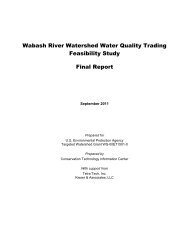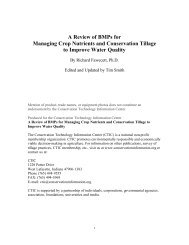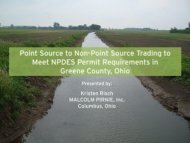Facilitating Conservation Farming Practices and Enhancing ...
Facilitating Conservation Farming Practices and Enhancing ...
Facilitating Conservation Farming Practices and Enhancing ...
You also want an ePaper? Increase the reach of your titles
YUMPU automatically turns print PDFs into web optimized ePapers that Google loves.
10<br />
<strong>Conservation</strong> Tillage Definitions<br />
The <strong>Conservation</strong> Technology Information Center (CTIC)<br />
has defined tillage systems according to the amount of<br />
crop residue left on the soil surface after planting <strong>and</strong><br />
the type of tillage tools used. Reductions in erosion are<br />
proportional to the presence of crop residue on the soil<br />
surface (Shelton, 2000).<br />
CTIC’s definitions include:<br />
<strong>Conservation</strong> tillage: Any tillage <strong>and</strong> planting system that<br />
covers more than 30 percent of the soil surface with crop<br />
residue, after planting, to reduce soil erosion by water. No-till,<br />
ridge-till <strong>and</strong> mulch-till are types of conservation tillage.<br />
No-till: The soil is left undisturbed from harvest to planting<br />
except for planting <strong>and</strong> nutrient injection. Planting or<br />
drilling is accomplished in a narrow seedbed or slots created<br />
by coulters, row cleaners, disk openers, in-row chisels<br />
or rotary tillers. Weed control is accomplished primarily<br />
by herbicides.<br />
Ridge-till: The soil is left undisturbed from harvest to<br />
planting except for nutrient injection. Planting is completed<br />
on a seedbed prepared on ridges with sweeps, disk<br />
openers, coulters or row cleaners. Residue is left on the<br />
surface between the ridges. Weed control is accomplished<br />
with herbicides <strong>and</strong>/or mechanical cultivation. Ridges are<br />
rebuilt during cultivation.<br />
Mulch-till: The soil is disturbed prior to planting. Tillage<br />
tools such as chisels, field cultivators, disks, sweeps <strong>and</strong><br />
blades are used. Weed control is accomplished with herbicides<br />
<strong>and</strong>/or mechanical cultivation.<br />
Conventional tillage leaves less than 15 percent residue cover<br />
after planting. It typically involves plowing or intensive<br />
tillage. Tillage types that leave 15-to-30-percent residue<br />
cover after planting sometimes are referred to as reduced<br />
tillage, but they do not qualify as conservation tillage.<br />
Continuous no-till: Maintaining no-till practices throughout<br />
the crop rotation cycle – avoiding the regular or periodic<br />
use of tillage – is called continuous no-till. The benefits of<br />
improved soil structure <strong>and</strong> carbon sequestration result<br />
from continuous no-till.<br />
Billions of Tons<br />
3.50<br />
3.00<br />
2.50<br />
2.00<br />
1.50<br />
1.00<br />
0.50<br />
0.00<br />
Erosion on Cropl<strong>and</strong> by Year<br />
Water (Sheet & Rill) Erosion<br />
total<br />
3.06 total<br />
2.79<br />
1.39<br />
1.67<br />
1.30<br />
1.49<br />
total<br />
2.17<br />
0.99<br />
1.18<br />
total<br />
1.89<br />
0.85<br />
1.04<br />
Wind Erosion<br />
total<br />
1.81<br />
0.80<br />
1.01<br />
1982 1987 1992 1997 2002 2007<br />
Cropl<strong>and</strong> includes cultivated <strong>and</strong> non-cultivated cropl<strong>and</strong>. Source: USDA NRCS Natural Resources Inventory, 2010.<br />
total<br />
1.72<br />
Despite the significant expansion of conservation tillage to date,<br />
erosion remains a tremendous threat to the productivity of the world’s<br />
soils, as well as to the quality of water <strong>and</strong> air. Clearly, the opportunity<br />
to take highly erodible fields out of crop production <strong>and</strong> farm other soils<br />
more productively <strong>and</strong> with less soil loss will continue to be important<br />
sustainability goals.<br />
When topsoil erodes – swept away by water or wind – it removes<br />
nutrients <strong>and</strong> well-structured soil from the field. That depletes the very<br />
layer of soil that is most hospitable to seeds <strong>and</strong> plants <strong>and</strong> sweeps<br />
away organic matter so valuable to soil health. It also results in the<br />
transport of sediment, pesticides <strong>and</strong> excess nutrients – especially<br />
phosphorus, which tends to be bound to the soil particles – to rivers,<br />
lakes <strong>and</strong> oceans, where they can disrupt natural ecological cycles.<br />
According to the U.S. Department of Agriculture Natural Resources<br />
<strong>Conservation</strong> Service (NRCS), an estimated 60 percent of the nation’s<br />
total river-borne sediment is the product of erosion from agricultural<br />
fields (USDA NRCS, 1997).<br />
Sediment clouds the water, reducing light penetration <strong>and</strong> reducing<br />
photosynthesis of submerged plants <strong>and</strong> algae. It can also clog the gills<br />
of aquatic organisms. Pesticides in streams <strong>and</strong> rivers can disrupt local<br />
plants, fish, macro invertebrates <strong>and</strong> other organisms.<br />
Excess nutrients can cause algal blooms that in turn disrupt natural<br />
vegetation or even deplete the water of the oxygen needed by local<br />
aquatic communities to survive. In its 2004 National Water Quality<br />
0.76<br />
0.96








